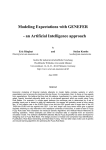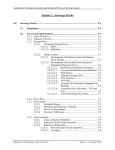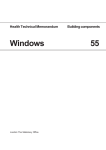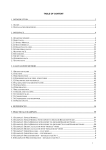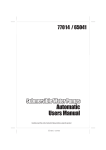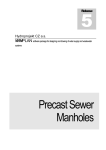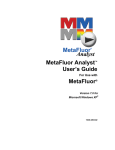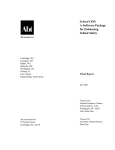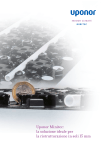Download Electronic Copy - RIBA Product Selector
Transcript
Electronic Copy CI/SfB (5.3) Titan Pollution Control Ltd West Portway Andover Hampshire SP10 3LF Tel: 01264 357666 Fax: 01264 366446 Designated by Government to issue European Technical Approvals Product • THIS CERTIFICATE RELATES TO TITAN SEWAGE TREATMENT PLANT. • Each product is for the treatment of domestic sewage. • The products are for use in conjunction with domestic drains and public and private sewers for the collection and treatment of domestic sewage as is permitted to be discharged by the Water Industry Act 1991, the Sewerage (Scotland) Act 1968 and the Water and Sewage Services (Northern Ireland) Order 1973. • This Certificate does not cover the use of any of the products for untreated trade effluents. This Front Sheet must be read in conjunction with the accompanying Detail Sheet, which provides information to specific products. Agrément Certificate No 98/3534 Second issue* TITAN SEWAGE TREATMENT PLANT Systèmes de traitement des aux résiduaires Abwasseraufbereitung Regulations — Detail Sheet 1 1 The Building Regulations 2000 (as amended) (England and Wales) Titan Sewage Treatment Plant is not subject to these Regulations. However, in the opinion of the BBA, the product will satisfy or contribute to satisfying the provisions under Section 59 of the Building Act 1984. 2 The Building Standards (Scotland) Regulations 1990 (as amended) In the opinion of the BBA, the position of Titan Sewage Treatment Plant, if used in accordance with the provisions of this Certificate, will satisfy or contribute to satisfying the various Regulations and related Technical Standards as listed below. Regulation: Standards: 10 B2.1 and B2.2 Fitness of materials and workmanship Selection and use of materials, fittings, and components, and workmanship Comment: Regulation: Standard: 24 M2.5 Drainage Drainage system — Wastewater and surface water drainage The products are acceptable. The products can meet the relevant requirements of this Technical Standard. See the marked sections of the Design Data part of the accompanying Detail Sheet. Comment 3 The Building Regulations (Northern Ireland) 2000 In the opinion of the BBA, Titan Sewage Treatment Plant, if used in accordance with the provisions of this Certificate, will satisfy or contribute to satisfying the various Building Regulations as listed below. Regulation: Comment: Regulation: Comment: B2 Fitness of materials and workmanship The products are acceptable. N6 Cesspools, septic tanks and similar structures The products can meet the relevant requirements of this Regulation. See the marked sections of the Design Data part of the accompanying Detail Sheet. 4 Construction (Design and Management) Regulations 1994 (as amended) Construction (Design and Management) Regulations (Northern Ireland) 1995 (as amended) Information in this Certificate may assist the client, planning supervisor, designer and contractors to address their obligations under these Regulations. See section: 2 Delivery and site handling (of the relevant Detail Sheet). 5 The Health and Safety at Work etc Act 1974 and the Health and Safety at Work (Northern Ireland) Order 1978 In buildings subject to this Act and Order, regular maintenance is a requirement for Titan Sewage Treatment Plant. See the section on Cleaning and maintenance in the respective Detail Sheet. Readers are advised to check the validity of this Certificate by either referring to the BBA’s website (www.bbacerts.co.uk) or contacting the BBA direct (Telephone Hotline 01923 665400). Electronic(b) Copy continue to be checked by the BBA or its Conditions of Certification agents; and (c) are reviewed by the BBA as and when it considers appropriate. 5 Conditions 5.1 This Certificate: (a) relates only to the product that is described, installed, used and maintained as set out in this Certificate; (b) is granted only to the company, firm or person identified on the front cover — no other company, firm or person may hold or claim any entitlement to this Certificate; (c) has to be read, considered and used as a whole document — it may be misleading and will be incomplete to be selective; (d) is copyright of the BBA. 5.2 References in this Certificate to any Act of Parliament, Regulation made thereunder, Directive or Regulation of the European Union, Statutory Instrument, Code of Practice, British Standard, manufacturers’ instructions or similar publication, shall be construed as references to such publication in the form in which it was current at the date of this Certificate. 5.3 This Certificate will remain valid for an unlimited period provided that the product and the manufacture and/or fabricating process(es) thereof: (a) are maintained at or above the levels which have been assessed and found to be satisfactory by the BBA; 5.4 In granting this Certificate, the BBA makes no representation as to: (a) the presence or absence of any patent or similar rights subsisting in the product or any other product; (b) the right of the Certificate holder to market, supply, install or maintain the product; and (c) the nature of individual installations of the product, including methods and workmanship. 5.5 Any recommendations relating to the use or installation of this product which are contained or referred to in this Certificate are the minimum standards required to be met when the product is used. They do not purport in any way to restate the requirements of the Health & Safety at Work etc Act 1974, or of any other statutory, common law or other duty which may exist at the date of this Certificate or in the future; nor is conformity with such recommendations to be taken as satisfying the requirements of the 1974 Act or of any present or future statutory, common law or other duty of care. In granting this Certificate, the BBA does not accept responsibility to any person or body for any loss or damage, including personal injury, arising as a direct or indirect result of the installation and use of this product. In the opinion of the British Board of Agrément, Titan Sewage Treatment Plant is fit for its intended use provided it is installed, used and maintained as set out in this Certificate. Certificate No 98/3534 is accordingly awarded to Titan Pollution Control Ltd. On behalf of the British Board of Agrément Date of Second issue: 10th January 2003 Chief Executive *Original Certificate issued on 12th November 1998. This amended version includes a change to the Certificate holder’s name, the product’s name and reference to the revised national Building Regulations and CDM Regulations. British Board of Agrément P O Box No 195, Bucknalls Lane Garston, Watford, Herts WD25 9BA Fax: 01923 665301 ©2003 e-mail: [email protected] website: www.bbacerts.co.uk For additional information about the Certificate, tel: 01923 665300. For information about Agrément Certificate validity and scope, tel: Hotline 01923 665400, or check the BBA website. Electronic Copy CI/SfB (5.3) Titan Pollution Control Ltd Certificate No 98/3534 DETAIL SHEET 2 Second issue* TITAN MINITEC AND BIOTEC Product • THIS DETAIL SHEET RELATES TO THE TITAN MINITEC AND BIOTEC SELF-CONTAINED SEWAGE TREATMENT PLANTS IN SIZES SUITABLE FOR POPULATIONS UP TO 4 (THE MINITEC) AND 6, 12, 18 AND 25 (THE BIOTEC RANGE). • The product is for use in sewage treatment systems designed in accordance with the recommendations of BS 6297 : 1983, for the retention of domestic sewage, separation and collection of solids, biological treatment of settled sewage and settlement of humus solids in suspension prior to discharge of the treated effluent. This Detail Sheet must be read in conjunction with the Front Sheet, which gives the product’s position regarding the Building Regulations, and the Conditions of Certification. Technical Specification 1 Description 1.1 The Titan Minitec and Biotec (see Figure 1) have the form of a cylindrical tank tapering to a hemispherical base. The units are constructed from glass-reinforced polyester (GRP) made of chopped strand glass fibres, laminated in a polyester resin system. The primary and final settlement zones are separated by a partition incorporating a large vertical screen. In the final zone is an air-lift pump operated by a remotely sited blower. A distributor and biological filter bale (composite plastic media with a high specific surface area) are suspended above the two zones. 1.2 The inlet and outlet sockets are 110 mm PVC-U and Kitemarked to BS EN 1401-1 : 1998. Each socket incorporates a captive rubber ring to BS EN 681-1 : 1996 Type WC. The sockets are designed to accept PVC-U pipe spigots but connection to other systems (eg vitrified clayware to BS 65 : 1991 and BS EN 295 : 1991) can be made by means of a short length of PVC-U pipe, to BS EN 1401-1 : 1989, and appropriate adaptors. with any humus from the final settlement tank. The liquor is recycled by the air-lift pump and distributed over the media. The biological filter bale promotes internal distribution of the liquor over the media and provides an evenly wetted surface on which the biomass grows. The biomass consumes the major part of the incoming biological load. 1.5 The treated sewage from the biological filter bale is again allowed to settle, allowing humus solids to separate as the clarified liquor is passed through the final up-flow zone. The effluent is then discharged to a water course or soakaway. 1.6 Continuous quality control is exercised during manufacture to maintain product quality and includes carcass spray weight checks and visual inspection. Figure 1 Minitec and Biotec — general layout 1.3 Crude sewage passes through the inlet into the primary settlement zone, where the breakdown and storage of solids take place. Material larger than 10 mm in diameter cannot pass through the partition screen and either gradually breaks down sufficiently to pass through the screen, settles or forms a scum. Recirculation through the screen assists in preventing septicity. 1.4 The screened sewage liquid passes into the final settlement zone and is mixed with treated sewage coming from the biological filter together Readers are advised to check the validity of this Detail Sheet by either referring to the BBA’s website (www.bbacerts.co.uk) or contacting the BBA direct (Telephone Hotline 01923 665400). 2 Delivery and site handling Electronic3.8 Copy The dimensions and other particulars of the Minitec and Biotec are as shown in Table 1. 2.1 The Minitec and Biotec must be lifted using webbing slings of a suitable rating for the working load (see Table 1) attached to the designated lifting points. Lifting equipment should be selected by taking into account the unit weight, dimensions and the distance of lift required on site. 3.9 Titan Pollution Control Ltd offer their clients a maintenance service contract for regular inspection and necessary maintenance of the Minitec and Biotec units. Table 1 2.2 The product bears a label detailing the manufacturer’s name, product name and size (population) and that consent from the Environment Agency is normally required for a sewage treatment plant discharge, and labels denoting the inlet and outlet. Minitec and Biotec — basic information Model No P4 Maximum number of full-time residents (p/day) 4 Average flow (m3/day) 0.8 BOD load (kg/day) 0.24 Weight empty (kg) 180 O/A diameter (m) 1.8 O/A depth (m) 1.98 Inlet invert (m) 1.0 Inlet invert to base (m) 0.98 Outlet invert (m) 1.1 Motor rating (Watts) 60/85 Drainage fitting (mm) 110 Design Data 3 General 3.1 The Minitec and Biotec are suitable for the collection and treatment of domestic sewage from households of up to 25 people. The appropriate model for the population, Biochemical Oxygen Demand (BOD) and average flow should be selected using the details given in Table 1. P6 6 1.2 0.36 200 1.8 2.2 1.0 1.2 1.1 60/85 110 P12 P18 P25 12 2.4 0.72 250 1.8 2.7 1.0 1.7 1.1 60/85 110 18 3.6 1.08 300 2.6 2.6 1.0 1.6 1.15 150 110 25 5.0 1.5 320 2.6 2.6 1.0 1.6 1.15 150 110 4 Strength 4.1 The manufacturer’s design has been assessed as satisfactory. The Minitec and Biotec have adequate strength to resist damage from minor impacts during handling. They must be slung at the lifting points provided (see section 2.1). 3.2 The general design of the installation should be in accordance with BS 6297 : 1983. 4.2 The Minitec and Biotec must be installed in accordance with the Installation Guidelines provided with the units (see section 10 for installation summary). Particular attention should be given to the provision of concrete backfill to resist flotation due to groundwater. 3.3 The Minitec and Biotec should be sited as far as possible from domestic dwellings, in accordance with the relevant Building Regulations. 3.4 Groundwater and flood levels should always be below plant outlet level, unless specific arrangements have been made to overcome this problem. 5 Resistance to chemicals 3.5 Where discharge is required to be at a higher level, an internal pumped outlet option is available. The item has not been covered by the scope of this assessment. The Minitec and Biotec are resistant to the small quantities of acid, alkali or other substances likely to be found in normal domestic sewage or the surrounding backfill. 3.6 The discharge from the unit must be to a suitable sub-soil irrigation system or water course in accordance with the requirements of the Environment Agency or the Scottish Environment Protection Agency. 6 Watertightness The Minitec and Biotec, when correctly installed, will not allow seepage either into or from the surrounding soil. The pipe joints, when correctly made, will be watertight. 3.7 The treated effluent discharging from the Minitec and Biotec will normally be to Band 1 of Table 10 of BS 7781 : 1994 [ie suspended solids (SS) content <30 mg per litre, Biochemical Oxygen Demand (BOD5) <20 mg per litre, and ammoniacal nitrogen <10 mg per litre], provided the hydraulic and BOD loadings are within the manufacturer’s specifications (see section 3.1). Under certain conditions the effluent may not be within these Standards. This is normal for any biological sewage treatment process and can be caused by unusual hydraulic or BOD loading, weather conditions, contamination by greases, excessive amounts and/or strength of laundry wastewater or poisoning of the microbiological fauna and flora by chemicals or antibiotics. 7 Cleaning and maintenance 7.1 Cleaning and maintenance should be carried out in accordance with the User’s Manual supplied with each unit. When carrying out any work on a Minitec or Biotec it is important to observe all the Health and Safety warnings in the User’s Manual. 7.2 Desludging is effected by a suction tanker, taking care to avoid damage by the hose nozzle. 7.3 Local damage to GRP components can be repaired by the manufacturer or a suitably experienced person using standard GRP repair techniques. Repairs must be carried out in dry conditions and the GRP laminate to be repaired must be thoroughly cleaned, dried, lightly abraded and prepared with a suitable bonding agent. 2 Flooding ElectronicSitingCopy 7.4 The blower housing should be installed above flood level, therefore minimising the requirements for repair or replacement due to flood damage. 9.7 The Minitec and Biotec should be sited so that: • they are not prejudicial to the health of any person • there is an adequate means of access for emptying. Frequency of inspection 10 Procedure 10.1 The excavation must be large enough for easy placement of the unit, to permit subsequent backfilling and to allow timbering and sheeting. 7.5 Where the system is installed and used in situations subject to The Health and Safety at Work etc Act 1974 and The Health and Safety at Work (Northern Ireland) Order 1978, an inspection of the system must be carried out every 12 months. Dry sites 10.2 A hole is excavated to allow sufficient clearance around the sides and the base of the tank. A 150 mm thick level base of concrete (C30; semi-dry) is laid and the tank lowered onto the levelled concrete, ensuring the top of the tank is level and that all the connections line up. When the tank is in position it is filled with water, back fill with pea-shingle (not larger than 12 mm rounded aggregate material) is commenced at the same time. It is essential that the underside of the tank is evenly supported and there are no voids. Any cohesive material or sharp objects which may form voids and associated point loads must not be used. Back filling is continued to just below outlet level. The inlet, outlet and air duct connections are made. Back filling is continued to just above the inlet drainage pipework with pea shingle and then to ground level with free-flowing soil. 8 Durability The structural properties of the GRP from which the tank is constructed, in common with all similar materials, will deteriorate with time. The deterioration is accelerated by contact with groundwater, sewage and dissolved or suspended organic or inorganic compounds (the resulting loss of strength and stiffness has been taken into account in the manufacturer’s design code). The GRP components should remain serviceable for at least 20 years. The mechanical and electrical components are liable to wear during operation, but the design layout is such that they can be replaced as required. Installation Wet sites 10.3 Having excavated, if the base is excessively wet or unstable, 200 mm of hard core is laid and lined with polythene, prior to laying the 150 mm level base of C30; semi-dry concrete. If necessary, a sump hole to one corner of the excavation is made to accommodate a suction hose from a site pump, thereby keeping the excavation as dry as possible. The tank is lowered onto the levelled concrete, ensuring the top of the tank is completely level and that all connections line up. When the tank is in position it is filled with water, back fill with concrete to just below the inlet/outlet levels is commenced at the same time. It is important that these two operations are carried out simultaneously to avoid the risk of flotation. When back filling with concrete it is essential that the underside of the tank is evenly supported without voids. The use of vibrating lances is not recommended. The inlet/ outlet and air duct connection is made. Back filling with concrete is continued to 300 mm above the inlet pipework and the installation is completed as given in the instructions for dry sites. 9 General 9.1 Titan Pollution Control Ltd can advise clients of the installation requirements. A national network of certified installers exists, who can offer a full installation service. 9.2 Electrical connections to the Minitec and Biotec unit from the control box must be carried out by a competent person using material suitable for the purpose. 9.3 Electrical connections must be in strict accordance with the manufacturer’s instruction and the IEE Wiring Regulations — Regulations for Electrical Installations, Sixteenth Edition 1991. Cables must be protected from accidental damage, eg by a suitable conduit. 9.4 The blower housing can be sited anywhere with access to mains electricity within a 15 m radius of the plant itself. 9.5 The Minitec and Biotec must not be installed in areas liable to localised flooding without adequate protection as specified by the marketing company. 10.4 The blower housing base slab should be located 3 m to 13 m from the inlet of the plant such that the 15 m length of air line provided is sufficient. The concrete base should be 150 mm thick and must be large enough to accommodate the blower enclosure base, ie 450 mm by 650 mm. The location should take into account noise sensitivity and preferably be in a shaded position. Once the air hose is installed the annulus around the hose at the top of the duct should be sealed. 9.6 It is essential to take precautions to prevent damage by site traffic. Superimposed loads from vehicles should not be permitted within a distance equal to the depth of excavation, unless suitable structural protection is provided. A fence may be required to prevent vehicles from approaching too close to the unit. 3 Electronic12.5Copy Visits were made to sites to assess the Technical Investigations practicability and ease of installation. The following is a summary of the technical investigations carried out on the Titan Minitec and Biotec. 12.6 A survey was undertaken of existing sites, where the product had been installed, to assess its performance in use. Bibliography 11 Tests 11.1 Tests were carried out in accordance with MOAT No 9 : 1973 to determine: resin/glass ratio, based on BS 2782-10 : Method 1002 : 1977 Barcol hardness, based on BS 4549-1 : 1970 cross-breaking strength by water boil, based on methods in BS 3532 : 1962, Appendix C and BS 2782-3 : Method 335A : 1978 degree of cure, by the Coggeshall test. 11.2 The durability of the GRP on prolonged exposure to water was assessed by exposing samples to boiling water for 1000 hours and measuring the loss of cross-breaking strength, bending stiffness and ductility. 12 Investigations 12.1 An assessment was made of the structural calculations and assumptions made in the design of the Minitec and Biotec. 12.2 An examination was made of sample analyses of effluent from Biotec and Minitec units carried out to measure BOD, suspended solids content and ammoniacal nitrogen and the results compared to the requirements of BS 7781 : 1994. 12.3 Components were assessed for: watertightness degradation of properties from exposure to sewage, groundwater, dissolved salts and dilute acids or alkalis long-term loading conditions bought-in components’ suitability for use. 12.4 The manufacturing process was examined, including the methods adopted for quality control, and details were obtained of the quality and composition of the materials used. BS 65 : 1991 Specification for vitrified clay pipes, fittings and ducts, also mechanical joints for use solely with surface water pipes and fittings BS 2782-3 : Method 335A : 1978 Methods of testing plastics — Mechanical properties — Determination of flexural properties of rigid plastics BS 2782-10 : Method 1002 : 1977 Methods of testing plastics — Glass reinforced plastics — Determination of loss on ignition BS 3532 : 1962 Method for specifying unsaturated polyester resin systems BS 4549-1 : 1970 Guide to quality control requirements for reinforced plastics mouldings — Polyester resin mouldings reinforced with chopped strand mat or randomly deposited glass fibres BS 6297 : 1983 Code of practice for design and installation of small sewage treatment works and cesspools BS 7781 : 1994 Procedure for type testing of small biological wastewater treatment plants BS EN 295 : 1991 Vitrified clay pipes and fittings and pipe joints for drains and sewers BS EN 681-1 : 1996 Elastomeric seals — Material requirements for pipe joint seals used in water and drainage applications — Vulcanized rubber BS EN 1401-1 : 1998 Plastics piping systems for non-pressure underground drainage and sewerage. Unplasticized poly(vinylchloride) (PVC-U) — Specifications for pipes, fittings and the system MOAT No 9 : 1973 Directive for the Assessment of Products in Glass-Reinforced Polyester for use in Building On behalf of the British Board of Agrément Date of Second issue: 10th January 2003 Chief Executive *Original Detail Sheet issued on 12th November 1998. This amended version includes a change to the Certificate holder’s name, the product’s name and a revised Bibliography. British Board of Agrément P O Box No 195, Bucknalls Lane Garston, Watford, Herts WD25 9BA Fax: 01923 665301 ©2003 e-mail: [email protected] website: www.bbacerts.co.uk For additional information about the Certificate, tel: 01923 665300. For information about Agrément Certificate validity and scope, tel: Hotline 01923 665400, or check the BBA website.







